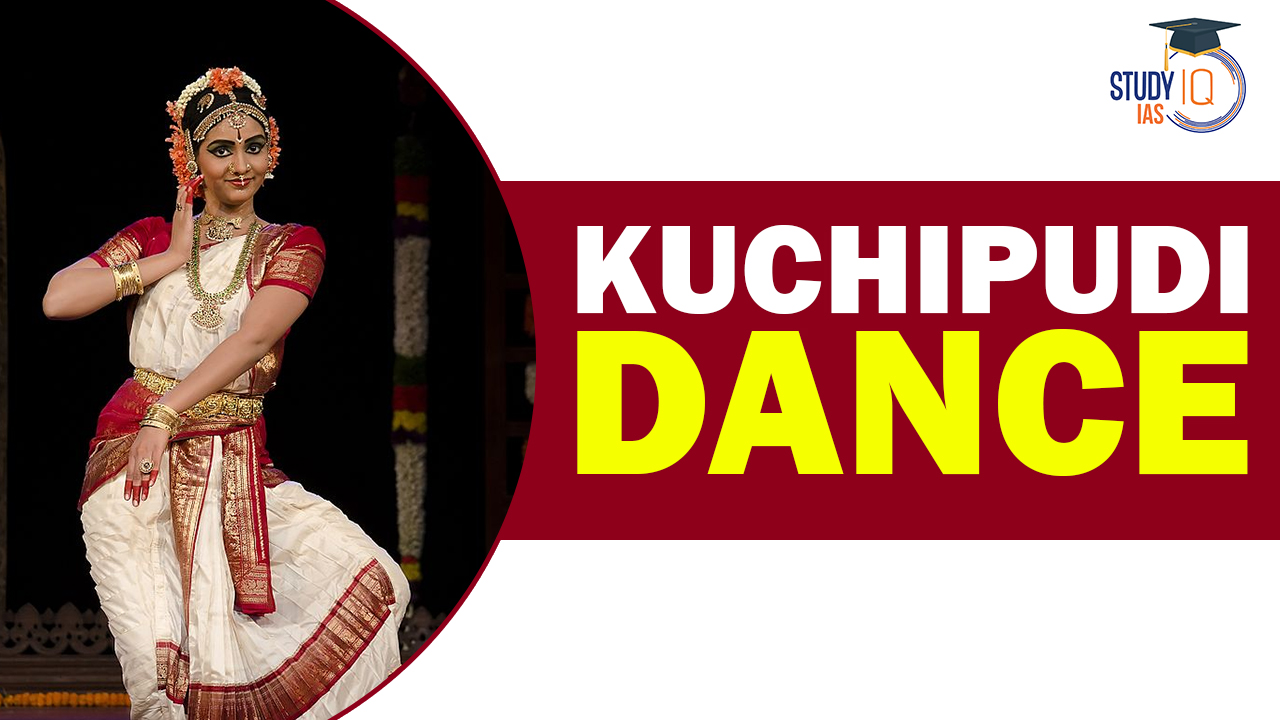Table of Contents
Kuchipudi, a classical Indian dance from Andhra Pradesh, seamlessly blends dance, drama, and music. Rooted in the Natya Shastra, it features vibrant costumes, expressive makeup, and intricate hand gestures (mudras). Abhinaya, or storytelling through expression, is pivotal. Performances include dynamic footwork, rhythmic ghungroos, and a repertoire spanning mythological tales to contemporary themes. Kuchipudi, often performed solo or in groups, preserves tradition while embracing contemporary influences, making it a celebrated and evolving art form worldwide.
We’re now on WhatsApp. Click to Join
Kuchipudi Dance: Indian Classical Dance
Kuchipudi, a prominent Indian classical dance, is among the ten leading classical dance forms in India. Originating in a Krishna district village in Andhra Pradesh, it is a dance-drama rooted in the ancient Hindu Sanskrit text, ‘Natya Shastra.’
With historical connections to temples and spiritual traditions, Kuchipudi’s origins date back to 10th-century copper inscriptions and 15th-century texts like ‘Machupalli Kaifat.’ Traditionally attributed to the 17th-century efforts of Tirtha Narayana Yati and his disciple Siddhendra Yogi, this dance form’s repertoire focuses on Lord Krishna and Vaishnavism, incorporating elements like invocation, dharavu, nritta, and nritya.
Kuchipudi Dance History and Evolution
Roots in ‘Natya Shastra’:
The theoretical foundation of Kuchipudi is traced back to the ancient Sanskrit text ‘Natya Shastra,’ credited to the Indian theatrologist and musicologist Bharata Muni.
Period of Origin:
The full version of ‘Natya Shastra’ is believed to have been completed between 200 BCE and 200 CE, although some variations suggest a broader timeline between 500 BCE and 500 CE.
Types of Dance:
‘Natya Shastra’ classifies dance into two types: ‘nrita,’ pure technical dance, and ‘nritya,’ solo expressive dance. It delves into various dance theories, including postures, bhava, rasa, basic steps, acting methods, gestures, and the Tandava dance associated with Lord Shiva.
Andhra Region References:
Bharata Muni mentions the Andhra region in ‘Natya Shastra,’ attributing the elegant movement ‘Kaishiki vritti’ and the raga ‘Andhri’ to this region.
Brahmana Melas and Vaishnavism:
10th-century copper inscriptions validate Shaivism-associated dance dramas called ‘Brahmana Melas’ in South India. Vaishnavism embraced Kuchipudi, evolving in the Tamil region as ‘Bhagavata Mela Nataka’ and in Andhra as Kuchipudi.
Influence of Karnataka’s ‘Yakshagana’:
Kuchipudi and ‘Bhagavata Mela Nataka’ share connections with Karnataka’s traditional theater form, ‘Yakshagana,’ incorporating Carnatic music with distinct variations in costume, format, and ideas.
Eastern Ganga Dynasty’s Role:
Kuchipudi is believed to have emerged in the late 13th century under the patronage of the Eastern Ganga dynasty, influenced by works like Jayadeva’s ‘Gita Govinda.’
Initiators in the 17th Century:
Tirtha Narayanayati and Sidhyendra Yogi, in the 17th century, are credited with initiating, methodizing, and arranging the present-day version of Kuchipudi.
Sri Krishna Leela Tarangini:
Narayanayati’s Sanskrit opera, ‘Sri Krishna Leela Tarangini,’ covers Lord Krishna’s life and has been a significant libretto for Kuchipudi performances over the centuries.
Village Origin and Name:
Sidhyendra Yogi, finding performers in the village of Kuchelapuram, received permission to stage the play annually. The dance form derived its name, Kuchipudi, from this village, also known as Kuchilapuri.
Flourishing and Decline in Medieval Era:
Kuchipudi flourished in the 16th century under medieval rulers, evidenced by copper inscriptions and performances at the Vijayanagara Empire court. However, Islamic invasions, Deccan Sultanates’ establishment, and the Vijayanagara Empire’s defeat in 1565 led to its decline.
Revival Efforts:
The last Shia Muslim Nawab of Golkonda, Abul Hasan Qutb Shah, supported a revival in 1678. Colonial rule in the 18th and 19th centuries, along with bans on temple dancing, contributed to the art form’s decline.
Revival During Freedom Movement:
Indian classical dance revivalists, including Vedantam Lakshminarayana Sastri, played key roles in the early 20th century. Efforts intensified between 1920 and 1950, with figures like Chinta Venkataramayya and Vempati Venkata Narayana Sastri contributing to Kuchipudi’s preservation and popularization.
Western Influence and Ragini Devi:
Western artists, such as American dancer Esther Sherman (Ragini Devi), contributed to the revival movement, demonstrating a cross-cultural exchange in the art form’s resurgence.
Kuchipudi Dance Repertoire
Kuchipudi’s repertoire consists of three performance categories: ‘Nritta’ (Nirutham), ‘Nritya’ (Niruthiyam), and ‘Natya’ (Natyam), in line with major Indian classical dance traditions.
- Nritta (Nirutham):
- Focuses on technical aspects of dance.
- Emphasizes pure dance movements without narrative or interpretive elements.
- Highlights speed, form, pattern, range, and rhythmic aspects.
- Nritya (Niruthiyam):
- Involves storytelling and communication of narratives.
- Expressive gestures and slower body movements convey spiritual themes, often centered around Lord Krishna.
- Harmonizes movements with musical notes to evoke emotions and engage the audience.
- Natya (Natyam):
- Typically performed in a group or solo setting.
- Involves dance-acting, maintaining specific body movements for characters in a play.
- Communicates the narrative through a combination of dance and theatrical elements.
These categories follow the principles outlined in the ancient Sanskrit text, ‘Natya Shastra,’ and are shared among various classical dance forms in India, showcasing a balanced blend of technical prowess, storytelling, and theatrical expression in Kuchipudi performances.
Kuchipudi Dance Costumes
- Male Character Attire:
- Wears a traditional dhoti, a garment wrapped around the waist and extending down the legs.
- Female Character Attire:
- Adorns a colourful sari with pleats that open like a hand fan during leg movements.
- Stitched pleated cloth enhances visual appeal during spectacular footwork.
- Make-Up:
- Generally light makeup is applied.
- Traditional jewellery complements the regional style, including accessories for the hair, nose, ears, arms, and neck.
- Waist Adornments:
- Sports a light metallic waist belt made of gold or brass.
- Anklet with Ghunghroo:
- Wears a leather anklet with small metallic bells (ghunghroo) on the ankles.
- Produces rhythmic sounds, enhancing the auditory experience during footwork.
- Hairstyle:
- Hair is neatly braided and may be adorned with flowers or styled in Tribhuvan, symbolizing the three worlds.
- Eye Expressions:
- Highlights eye expressions with black collyrium outlining.
- Special Costumes and Props:
- Occasionally, specific characters or plays may require unique costumes and props.
- Example: A dancer portraying Lord Krishna might wear a peacock feathered crown.
- These elements collectively contribute to the visual and auditory richness of the Kuchipudi performance, enhancing the storytelling and expressive aspects of the dance form.
Kuchipudi Dance Instruments and Music
- Conductor (Sutradhara or Nattuvanar):
- Guides the entire performance.
- Recites musical syllables and uses cymbals for rhythmic beats.
- Vocalists:
- The story or spiritual message is sung by the conductor, another vocalist, or actor-dancers.
- Musical Instruments:
- The ensemble includes cymbals, mridangam (a percussion instrument), tambura (a string instrument), veena (a plucked string instrument), and flute.
Kuchipudi Dance Famous Exponents
- Indrani Bajpai (Indrani Rahman):
- Daughter of Ragini Devi.
- Contributed to the art’s expansion through public performances beyond Andhra.
- Played a pivotal role in making Kuchipudi popular nationally and internationally.
- Yamini Krishnamurti:
- Renowned dancer who, alongside Indrani Rahman, expanded the reach of Kuchipudi through public performances.
- Raja and Radha Reddy:
- Internationally acclaimed dancing couple.
- Made significant contributions to popularizing Kuchipudi on global stages.
- Yamini Reddy:
- Daughter of Raja and Radha Reddy.
- Carries on the family legacy, contributing to the international fame of Kuchipudi.
- Kaushalya Reddy:
- Accomplished Kuchipudi dancer, associated with the famous Reddy dancing family.
- Bhavana Reddy:
- Daughter of Raja and Kaushalya Reddy.
- Established herself as a notable Kuchipudi artist.
- Lakshmi Narayn Shastri:
- Recognized as an eminent Kuchipudi dancer, contributing to the art form’s legacy.
- Swapana Sundari:
- Notable Kuchipudi dancer, adding to the richness of the tradition.
Kuchipudi Dance UPSC
Kuchipudi, a classical dance from Andhra Pradesh, seamlessly amalgamates dance, drama, and music, rooted in the ancient ‘Natya Shastra.’ Expressing through vibrant costumes, expressive makeup, and intricate hand gestures (mudras), Kuchipudi focuses on abhinaya, and storytelling through expression. Performances feature dynamic footwork, rhythmic ghungroos, and a repertoire spanning mythological tales to contemporary themes.
Often performed solo or in groups, Kuchipudi preserves tradition while embracing contemporary influences, evolving as a celebrated art form globally. Renowned exponents like Indrani Bajpai, Yamini Krishnamurti, and the Reddy family have played pivotal roles in its international recognition and continued legacy.
| Other Classical Dances of India | |
| Bharatanatyam Dance | Kathak Dance |
| Kuchipudi Dance | Manipuri Dance |
| Kathakali Dance | Mohiniyattam Dance |
| Sattriya Dance | Odissi Dance |


 Bihu Festival and Dance of Assam, Histor...
Bihu Festival and Dance of Assam, Histor...
 Chittorgarh Fort: Mining Ban within 10 k...
Chittorgarh Fort: Mining Ban within 10 k...
 PM Modi visits Wat Pho Temple in Bangkok
PM Modi visits Wat Pho Temple in Bangkok





















